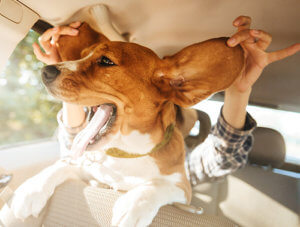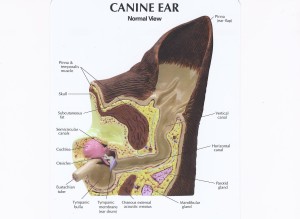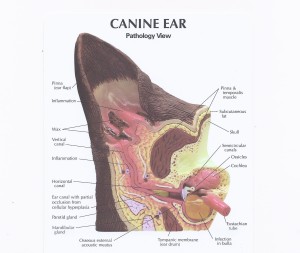The first step in becoming comfortable in cleaning our dogs’ ears is  understanding the anatomy. A dog’s ear canal is a long, “L” shaped tube in which the ear drum is protected by being a distance from the surface. The dog’s ear canal has a vertical canal, a nearly 90 degree turn, and a horizontal canal prior to reaching the ear drum (tympanic membrane). It is quite different from our ear canal which is short and straight, and it is easy to touch the ear drum. Because the dog’s ear drum is literally inches away and past a curve, it is difficult to cause harm.
understanding the anatomy. A dog’s ear canal is a long, “L” shaped tube in which the ear drum is protected by being a distance from the surface. The dog’s ear canal has a vertical canal, a nearly 90 degree turn, and a horizontal canal prior to reaching the ear drum (tympanic membrane). It is quite different from our ear canal which is short and straight, and it is easy to touch the ear drum. Because the dog’s ear drum is literally inches away and past a curve, it is difficult to cause harm.
It is this anatomy that makes dogs so easily predisposed to ear infections. The ear canal is naturally deep and dark, so any moisture (humidity, bathing, swimming, etc.) will easily contribute to an infection. The goal of cleaning your dog’s ears is to maintain a dry environment which discourages growth of bacteria and yeast. The process of cleaning your dog’s ears during an infection and maintaining a healthy ear canal by routine cleaning differs only in frequency.
 Generously apply a safe ear cleaner as directed by your veterinarian and massage the ear canal. Do not use household products such as vinegar, alcohol or hydrogen peroxide. Sufficient cleaner has been applied when a swishing sound can be heard as you massage the ear canal, loosening debris and driving it to the surface. Using cotton balls, wipe the ear canal by inserting your finger as deeply as it may go. Although this sounds aggressive, your finger cannot make the curve of the “L” shape and cannot reach the ear drum. Continue to flush the ear with cleaning solution and wipe with cotton balls until the canal is clean and the cotton balls are removed with very little or no debris. After having an ear cleaning, your dog will often rub his head on the floor, against the furniture and shake his head excessively. Do not worry that you have done any harm. The ears simply feel wet and different to him.
Generously apply a safe ear cleaner as directed by your veterinarian and massage the ear canal. Do not use household products such as vinegar, alcohol or hydrogen peroxide. Sufficient cleaner has been applied when a swishing sound can be heard as you massage the ear canal, loosening debris and driving it to the surface. Using cotton balls, wipe the ear canal by inserting your finger as deeply as it may go. Although this sounds aggressive, your finger cannot make the curve of the “L” shape and cannot reach the ear drum. Continue to flush the ear with cleaning solution and wipe with cotton balls until the canal is clean and the cotton balls are removed with very little or no debris. After having an ear cleaning, your dog will often rub his head on the floor, against the furniture and shake his head excessively. Do not worry that you have done any harm. The ears simply feel wet and different to him.
I generally recommend cleaning weekly to every two weeks based on seasonal humidity and contact with water. During an infection, the frequency of cleaning is often increased to three times weekly. Signs of an ear infection include an unpleasant odor from the ear or an accumulation of excessive debris from your dog’s ears. If he demonstrates pain, incessant shaking of his head or scratching of his ears, please contact your veterinarian for an examination.
Mia K. Frezzo, DVM





